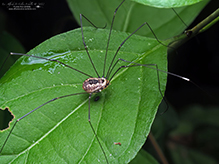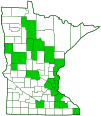Aldrich’s harvestman
(Leiobunum aldrichi)
Conservation • Description • Habitat • Biology • Distribution • Taxonomy
|
|
||||||||||||||
Description |
Aldrich’s harvestman is a small, native harvestman. It occurs in the United States and southern Canada east of the Great Plains, but it is absent from the deep south. Adults are active from June through September. They are found in mature deciduous forests on tree trunks, logs, stumps, boulders, and other surfaces. They appear to be absent from secondary forests, which appear after a significant disturbance, such a logging or agriculture. Adults are small bodied, but they have very long legs. Males are ⅛″ (3 to 4 mm) in length. The body is soft, compact, and oval. It is entirely brownish orange above with no obvious markings. The end of the abdomen is rounded. The underside is lighter. There are two simple eyes and no compound eyes. The eyes are mounted atop a tubercle (small, rounded protuberance). The tubercle is black. The legs are extremely long and slender. The leg length is variable. The second pair of legs is the longest, up to 3½″ (90 mm) long. Each leg consists of a coxa, trochanter, femur, patella, tibia, metatarsus, tarsus and claw. The legs are mostly dark brown or blackish. The coxae are pale, contrasting sharply with the dark trochanters. There is a white band at the outer end of the tibia, only on the second pair of legs. This is a distinguishing feature for the species. Females are 3⁄16″ to ¼″ (4.5 to 6.0 mm) in length. The color of the upper side of the body can vary from brown to orange. The margins of the carapace (the covering plate on the front part of the body) have a white background. There is a large, distinct, dark figure bordered by lighter areas extending from the eye area on the carapace to the end of the abdomen. Each abdominal segment has a band of light spots on either side of the central dark figure. The end of the abdomen is pointed. The underside of the body is white. |
Size |
Female Body Length: 3⁄16″ to ¼″ (4.5 to 6.0 mm) Male Body Length: ⅛″ (3 to 4 mm) Legspan: variable |
Similar Species |
Habitat |
Mature deciduous forests |
Biology |
Season |
June through September |
Behavior |
Adults are active during the day.. |
Life Cycle |
|
Food |
|
Distribution |
||
|
Sources |
|
| 7/9/2025 | ||
Occurrence |
||
|
||
Taxonomy |
|
Class |
|
Order |
|
Suborder |
Eupnoi |
Superfamily |
Phalangioidea |
Family |
Sclerosomatidae |
Subfamily |
Leiobuninae |
Genus |
|
Subordinate Taxa |
|
|
|
Synonyms |
|
Leiobunum gordoni Liobunum longipes Liobunum nigropalpi |
|
Common Names |
|
Aldrich’s harvestman |
|
Glossary
Carapace
The hard, upper (dorsal), shell-like covering (exoskeleton) of the body or at least the thorax of many arthropods and of turtles and tortoises. On crustaceans, it covers the cephalothorax. On spiders, the top of the cephalothorax made from a series of fused sclerites.
Coxa
The first (most proximal) segment of the legs of most arthropods, including all insects, spiders, and crustaceans, and most arachnids. It attaches the leg to the body and connects to the trochanter. Plural: coxae.
Tubercle
On plants and animals: a small, rounded, raised projection on the surface. On insects and spiders: a low, small, usually rounded, knob-like projection. On slugs: raised areas of skin between grooves covering the body.
Visitor Photos |
||
Share your photo of this arachnid. |
||
This button not working for you? |
||
Alfredo Colon |
 |
MinnesotaSeasons.com Photos |
||
|
||
|
||

Slideshows |
|

Visitor Videos |
||
Share your video of this arachnid. |
||
This button not working for you? |
||
|
Other Videos |
||
Leiobunum aldrichi |
About
Sep 21, 2024 |

|
Created: 7/9/2025 Last Updated: © MinnesotaSeasons.com. All rights reserved. |


